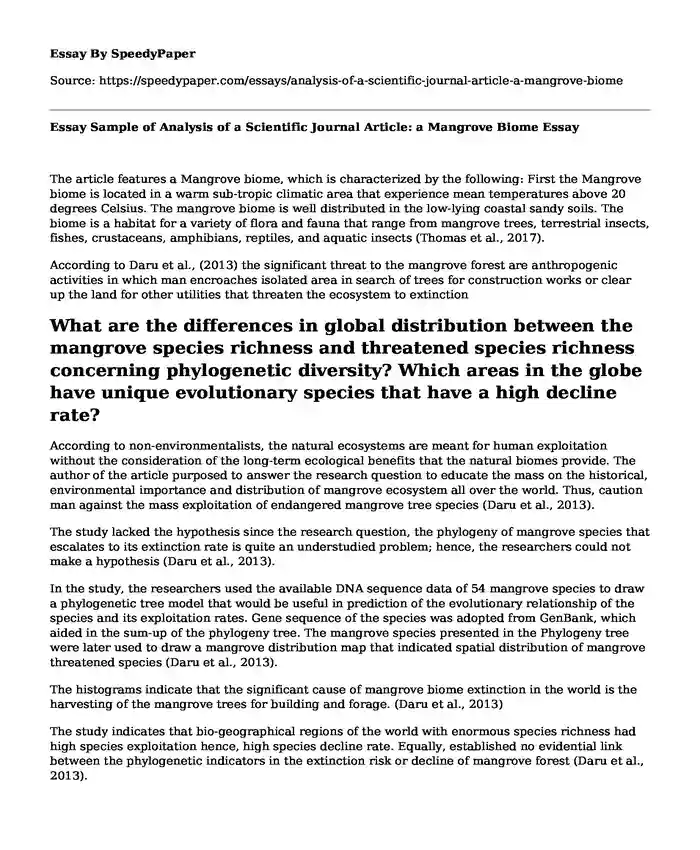The article features a Mangrove biome, which is characterized by the following: First the Mangrove biome is located in a warm sub-tropic climatic area that experience mean temperatures above 20 degrees Celsius. The mangrove biome is well distributed in the low-lying coastal sandy soils. The biome is a habitat for a variety of flora and fauna that range from mangrove trees, terrestrial insects, fishes, crustaceans, amphibians, reptiles, and aquatic insects (Thomas et al., 2017).
According to Daru et al., (2013) the significant threat to the mangrove forest are anthropogenic activities in which man encroaches isolated area in search of trees for construction works or clear up the land for other utilities that threaten the ecosystem to extinction
What are the differences in global distribution between the mangrove species richness and threatened species richness concerning phylogenetic diversity? Which areas in the globe have unique evolutionary species that have a high decline rate?
According to non-environmentalists, the natural ecosystems are meant for human exploitation without the consideration of the long-term ecological benefits that the natural biomes provide. The author of the article purposed to answer the research question to educate the mass on the historical, environmental importance and distribution of mangrove ecosystem all over the world. Thus, caution man against the mass exploitation of endangered mangrove tree species (Daru et al., 2013).
The study lacked the hypothesis since the research question, the phylogeny of mangrove species that escalates to its extinction rate is quite an understudied problem; hence, the researchers could not make a hypothesis (Daru et al., 2013).
In the study, the researchers used the available DNA sequence data of 54 mangrove species to draw a phylogenetic tree model that would be useful in prediction of the evolutionary relationship of the species and its exploitation rates. Gene sequence of the species was adopted from GenBank, which aided in the sum-up of the phylogeny tree. The mangrove species presented in the Phylogeny tree were later used to draw a mangrove distribution map that indicated spatial distribution of mangrove threatened species (Daru et al., 2013).
The histograms indicate that the significant cause of mangrove biome extinction in the world is the harvesting of the mangrove trees for building and forage. (Daru et al., 2013)
The study indicates that bio-geographical regions of the world with enormous species richness had high species exploitation hence, high species decline rate. Equally, established no evidential link between the phylogenetic indicators in the extinction risk or decline of mangrove forest (Daru et al., 2013).
The phylogeny analysis of extinction of mangrove forest is quite challenging to understand, in that, the study did not relate the species decline with their genetic variation. Initially, you may presume that the investigators will establish a link of extinction of a particular mangrove species based on its genetic sequence, which determines its anthropogenic uses in the globe (Daru et al., 2013).
The finding of the study can be used to conduct a global mass education campaign against the mass harvesting of mangrove tree species that have a significant ecological function. Notably, the establishment that mangrove trees are used for construction and forage it implies that the trees are logged without regulation in species enriched areas. The authors recommended that phylogeny to tree species should be a considerate factor for future researches in the field even though the current study lacked an evidential link between the mangroves plant's gene sequence and its exploitation rate (Daru et al., 2013).
References
Daru, B., Yessoufou, K., Mankga, L., & Davies, T. (2013). A Global Trend towards the Loss of Evolutionarily Unique Species in Mangrove Ecosystems. Plos ONE, 8(6).
Thomas, N., Lucas, R., Bunting, P., Hardy, A., Rosenqvist, A., & Simard, M. (2017). Distribution and drivers of global mangrove forest change, 1996-2010. PLOS ONE, 12(6).
Cite this page
Essay Sample of Analysis of a Scientific Journal Article: a Mangrove Biome. (2022, Nov 01). Retrieved from https://speedypaper.com/essays/analysis-of-a-scientific-journal-article-a-mangrove-biome
Request Removal
If you are the original author of this essay and no longer wish to have it published on the SpeedyPaper website, please click below to request its removal:
- Free Essay Sample: Political Correctness Vs. Common Sense
- Essay Sample on Why You Should Further Your Education
- Free Essay on Entrepreneurship Business Plan - Technological Restaurant
- Free Essay Sample: Culture and Structure
- Essay Example on Karaoke and Comprehension Skills Among Teens cith Learning Disabilities
- Free Essay: Texas Should Legalise the Medical and Recreational Use of Marijuana
- Essay Sample on Interpersonal and Team Skills - Team Charter
Popular categories





